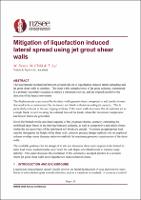Mitigation of liquefaction induced lateral spread using jet grout shear walls
Abstract
The load transfer mechanism between ground subject to liquefaction induced lateral spreading and jet grout shear walls is complex. The shear walls comprise rows of jet grout columns, constructed in a primary-secondary sequence to ensure a minimum overlap, and are aligned parallel to the direction of the lateral movement.
The displacements experienced by the shear walls generate shear, compressive and tensile stresses that need to be accommodated by the treated soil block without exceeding its capacity. This is particularly relevant in the overlapping sections of the shear walls, to ensure that all columns act as a single block, as well as along the external faces of the block, where the maximum compressive and tensile forces are generated.
Given the limited tensile and shear capacity of the jet grout columns, correctly estimating the mobilised shear forces in the interface between columns, as well as compressive and tensile forces within the toe and/or heel of the reinforced soil block are crucial. To ensure an appropriate load transfer throughout the height of the shear wall, common practice design methods rely on empirical column overlap versus diameter ratios to establish the minimum geometry requirements of the shear walls.
The available guidance for the design of in situ soil treatment shear walls appears to be limited to static load cases, predominantly underneath the side slopes of embankments to enhance slope stability. This paper discusses the adaptation of this commonly accepted practice to a scenario where jet grout shear walls resist liquefaction induced lateral spread.

